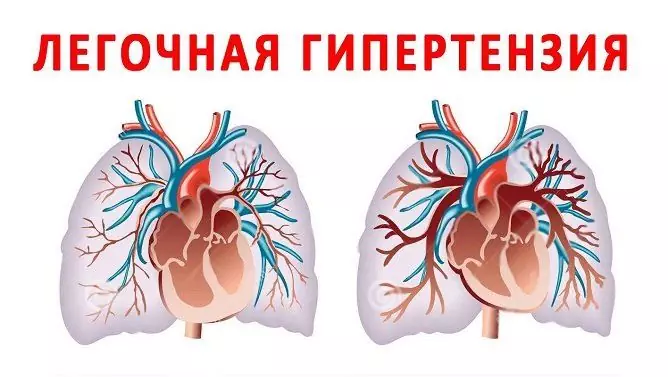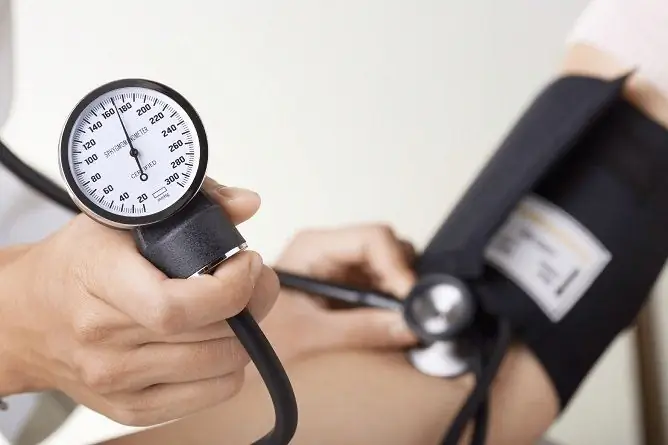- Author Rachel Wainwright [email protected].
- Public 2023-12-15 07:39.
- Last modified 2025-11-02 20:14.
Essential arterial hypertension
The content of the article:
- Essential hypertension - what is it?
- Stages
- Symptoms
- Possible complications
- Diagnostics
- Treatment
- Prevention
- Video
Essential hypertension (primary hypertension, essential arterial hypertension, essential hypertension) is a pathological condition in which blood pressure exceeds 140/90 mm Hg. Art. for a long time and which develops primarily, that is, it is not a consequence of any other pathology. ICD-10 code - I10.
Essential hypertension belongs to the most common pathologies of the cardiovascular system. According to the World Health Organization, it accounts for approximately 96% of all cases of arterial hypertension. The most vulnerable age in relation to this disease is 35-40 years.

Headache is the main, and sometimes the only sign of essential hypertension
Essential hypertension - what is it?
What is the difference between essential and other arterial hypertension? Other forms of hypertension are always secondary, that is, they are not an independent disease, but a symptom of another disease, most often associated with damage to the kidneys or heart. In the case of essential primary hypertension, a disease that could cause a persistent increase in blood pressure cannot be detected. Some researchers believe that psychosomatics plays the main role in the onset of the disease, i.e., disorders of the vascular bed develop under the influence of psychological factors, for example, stress.
The triggering mechanism of the disease is a change in the tone of the blood vessels, presumably under the influence of disorders from the nervous or endocrine system. Due to hypertonicity, arterioles spasm and blood pressure rises. Prolonged spasm of microvascular cells leads to their sclerosis, which further increases hypertension and becomes the cause of disruption of blood supply to tissues and organs.
Main risk factors:
- hereditary predisposition - in about 50% of cases in a family history there is an indication of arterial hypertension. It has been proven that epigenetic modification of certain genes plays a significant role in the development of pathology;
- obesity - increases the risk of developing arterial hypertension by 5 times. Overweight (body mass index above 25) is observed in more than 85% of patients.
Other predisposing factors include: a history of cardiovascular disease and / or in close relatives, metabolic diseases (diabetes mellitus, hypercholesterolemia, etc.), smoking, deficiency of vitamins, calcium and magnesium, passive lifestyle.
Stages
There are three stages (severity) of essential hypertension:
- Systolic blood pressure is 140-159, and diastolic blood pressure is 90-99 mm Hg. Art.; there are no signs of target organ damage.
- Systolic pressure is within 160-179, and diastolic pressure is 100-109 mm Hg. Art.; there is a narrowing of the blood vessels of the retina, as well as hypertrophy of the walls of the left ventricle.
- Systolic blood pressure is from 180, and diastolic - from 110 mm Hg. Art. and higher; objective signs of target organ damage.
Grades 1-2 are considered reversible conditions, morphological changes in grade 3 hypertension are irreversible.
Symptoms
The disease can be benign or malignant. In the first case, the patient's blood pressure level rises infrequently, and after taking antihypertensive drugs, it quickly returns to normal. The malignant form of the disease is characterized by the fact that blood pressure rises significantly and often, the patient rapidly increases damage to internal organs, while medications are usually ineffective.
A long asymptomatic course of the disease is possible. Before complications develop, the only symptom of the disease is often only high blood pressure, manifested by a headache.
The main clinical sign of pathology is headache of varying intensity - from a feeling of "heavy head" to extremely intense. The pain is usually localized in the back of the head, accompanied by tinnitus, flies before the eyes.
Symptoms are especially pronounced during a hypertensive crisis. This is a condition caused by a rapid and significant rise in pressure, manifested by intense headache, dizziness, nausea, vomiting, pain in the heart, weakness.
As the pathological process progresses and target organs are damaged, patients may experience signs of coronary heart disease, hypertensive encephalopathy, and intermittent claudication.
Possible complications
Essential hypertension can lead to dangerous complications: acute impairment of cerebral circulation, angina pectoris, dissecting aortic aneurysm, hemorrhages of different localization. Damage to the kidneys, central nervous system, visual analyzer, hypertensive heart (increases the risk of myocardial infarction, heart failure, ventricular arrhythmia) and a number of other complications may develop.
Diagnostics
Diagnostics uses data obtained from collecting complaints and anamnesis, conducting physical diagnostics, and measuring blood pressure. From laboratory diagnostic methods, you may need a general and biochemical blood test, a general urine test (proteinuria or microalbuminuria is detected).

The diagnosis is confirmed if the increased pressure is determined during three measurements at regular intervals
At least three blood pressure measurements should be taken to confirm the diagnosis (each measurement at a separate visit to the doctor). In some cases, daily monitoring of blood pressure is prescribed.
Blood pressure is measured on both hands, since discrepancies are possible that are associated with atherosclerotic lesions of the subclavian artery. If differences are found in the future, the pressure is measured on the same hand. In the sitting position, the blood pressure is slightly higher than in the supine position.
Of the instrumental methods for making a diagnosis, the following are used: electrocardiography, chest x-ray, ultrasound examination of the kidneys, echocardiography, ophthalmoscopy (focal or generalized narrowing of the retinal arteries is detected).
Essential hypertension is determined by the method of exclusion, that is, the diagnosis is made by excluding all possible secondary (symptomatic) hypertension. So, unlike essential renovascular (secondary) hypertension occurs suddenly, and does not develop gradually, in addition, with the renovascular form of the disease, the difference between systole and diastole is insignificant.
Do they take to the army with such a diagnosis? This is determined during a medical examination. The presence of persistent damage to target organs means the need for constant drug therapy and therefore is the basis for exemption from conscription.
Treatment
Since the cause of the development of essential hypertension has not been established, and it is not possible to eliminate it, the goal of treatment is to reduce the risk of developing severe complications.
First of all, it is necessary to correct the way of life, to improve it. Overweight patients need to normalize it by reducing the calorie intake and a moderate increase in physical activity. It is necessary to completely abandon bad habits, physical and psycho-emotional overload. A full night's sleep is obligatory, observance of a reasonable regime of work and rest.
Massage, physiotherapy exercises, swimming have a good therapeutic effect.
A diet low in salt (no more than 5 g per day) and heavy food is recommended. In addition to table salt itself, smoked meats, marinades, pickles, industrial products, alcohol and tonic drinks should be limited or completely excluded from the diet. The basis of the diet should be vegetables, fruits, cereals, dairy and sour-milk products, lean meats, fish.
With essential hypertension 1-2 degrees of lifestyle modification may be sufficient to provide a pronounced therapeutic effect and achieve a stable remission. But even in the case when these measures alone are not enough and drug therapy is required, their observance is necessary, since without a healthier lifestyle, the effect of drug therapy will be only temporary.
From medications, angiotensin-converting enzyme inhibitors, angiotensin II receptor antagonists, beta-blockers, calcium channel blockers, diuretics can be prescribed. The selection of medicines is carried out by a doctor, self-medication is strongly discouraged.
The disappearance of clinical signs of the disease is not a reason for discontinuing drug therapy. So, in case of stopping the intake of antihypertensive drugs, hypertension is restored within six months in 85% of cases.

In 85% of cases, essential hypertension is associated with excess weight
Prevention
In order to prevent essential hypertension, it is recommended, first of all, to lead a healthy lifestyle: adhere to the rules of a balanced diet and daily regimen, minimize stressful situations and develop stress resistance, avoid excessive physical exertion, and prevent excess weight.
Video
We offer for viewing a video on the topic of the article.

Anna Aksenova Medical journalist About the author
Education: 2004-2007 "First Kiev Medical College" specialty "Laboratory Diagnostics".
Found a mistake in the text? Select it and press Ctrl + Enter.






